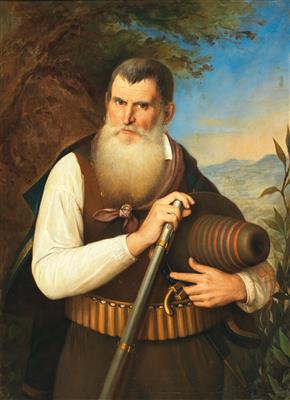Attributed to Filippo Balbi

(1806–1890)
Portrait of Antonio Gasbarrone (Sonnino 1793–1880 Abbiategrasso), monogrammed top left (in ligature) FB oil on canvas, 97.5 x 74 cm, framed, (Rei)
The brigand Antonio Gasbarrone, who wreaked havoc across the landscapes of central Italy, is probably the most well-known Italian bandit of the 19th century. He was born to a family of humble means on 12 December 1793 in Sonnino. He lost both his parents at the age of 15 and moved to the mountains of central Italy with his brother. After an unhappy love affair, he started his notorious career as an outlaw, dedicating himself to taking from the rich and defending the poor. The mountains and peaks of Monti Lepini and Monti Ausoni became places of refuge for him and his crew, and the starting point for his crimes against powerful individuals in Italy, whom he adjudged to be guilty. His crimes did not go unpunished. He was incarcerated in Spoleto from 1848 onwards, and from 1851 onwards in the stronghold of Civita, near Rome. His incarceration spread the legends surrounding the bandit outside Italy’s borders, leading him to be the inspiration for Carl Millöcker’s opera “Gasparone”. He also makes an appearance in Alexander Dumas’ adventure story “The Count of Monte Cristo”. The author himself visited the brigand in prison in the Civita stronghold in 1835. He was finally released in 1870, and spent the last years of his life in freedom as a chronicler before he died on 1 April 1882 in Abbiategrasso, aged 89.
His character aroused curiosity and awakened the imagination of the contemporary middle-class audience, who were attracted to the adventurous, romantic tales of the outlaw. Antonio Gasbarrone encouraged these legends himself: he wrote his memoirs from his cell, and sold them as souvenirs. These legends are also reflected in this portrait. The robber looks at the viewer with a determined gaze, while resting his right hand on his shotgun, the necessary tool of his trade. The cartridge belt hangs resplendently from his waist and his hat rests on his left arm. He is positioned in front of an Italian landscape, harking back to his hometown. A similar portrait of the brigand by Filippo Balbi can be found in the Galleria Dell’Academia di San Luca in Rome, depicting an oval half-length portrait of him.
Expert: Mag. Dimitra Reimüller
 Mag. Dimitra Reimüller
Mag. Dimitra Reimüller
+43-1-515 60-355
19c.paintings@dorotheum.at
24.10.2018 - 18:00
- Dosažená cena: **
-
EUR 8.750,-
- Odhadní cena:
-
EUR 7.000,- do EUR 10.000,-
Attributed to Filippo Balbi
(1806–1890)
Portrait of Antonio Gasbarrone (Sonnino 1793–1880 Abbiategrasso), monogrammed top left (in ligature) FB oil on canvas, 97.5 x 74 cm, framed, (Rei)
The brigand Antonio Gasbarrone, who wreaked havoc across the landscapes of central Italy, is probably the most well-known Italian bandit of the 19th century. He was born to a family of humble means on 12 December 1793 in Sonnino. He lost both his parents at the age of 15 and moved to the mountains of central Italy with his brother. After an unhappy love affair, he started his notorious career as an outlaw, dedicating himself to taking from the rich and defending the poor. The mountains and peaks of Monti Lepini and Monti Ausoni became places of refuge for him and his crew, and the starting point for his crimes against powerful individuals in Italy, whom he adjudged to be guilty. His crimes did not go unpunished. He was incarcerated in Spoleto from 1848 onwards, and from 1851 onwards in the stronghold of Civita, near Rome. His incarceration spread the legends surrounding the bandit outside Italy’s borders, leading him to be the inspiration for Carl Millöcker’s opera “Gasparone”. He also makes an appearance in Alexander Dumas’ adventure story “The Count of Monte Cristo”. The author himself visited the brigand in prison in the Civita stronghold in 1835. He was finally released in 1870, and spent the last years of his life in freedom as a chronicler before he died on 1 April 1882 in Abbiategrasso, aged 89.
His character aroused curiosity and awakened the imagination of the contemporary middle-class audience, who were attracted to the adventurous, romantic tales of the outlaw. Antonio Gasbarrone encouraged these legends himself: he wrote his memoirs from his cell, and sold them as souvenirs. These legends are also reflected in this portrait. The robber looks at the viewer with a determined gaze, while resting his right hand on his shotgun, the necessary tool of his trade. The cartridge belt hangs resplendently from his waist and his hat rests on his left arm. He is positioned in front of an Italian landscape, harking back to his hometown. A similar portrait of the brigand by Filippo Balbi can be found in the Galleria Dell’Academia di San Luca in Rome, depicting an oval half-length portrait of him.
Expert: Mag. Dimitra Reimüller
 Mag. Dimitra Reimüller
Mag. Dimitra Reimüller
+43-1-515 60-355
19c.paintings@dorotheum.at
|
Horká linka kupujících
Po-Pá: 10.00 - 17.00
kundendienst@dorotheum.at +43 1 515 60 200 |
| Aukce: | Obrazy 19. století |
| Typ aukce: | Salónní aukce |
| Datum: | 24.10.2018 - 18:00 |
| Místo konání aukce: | Wien | Palais Dorotheum |
| Prohlídka: | 13.10. - 24.10.2018 |
** Kupní cena vč. poplatku kupujícího a DPH
Není již možné podávat příkazy ke koupi přes internet. Aukce se právě připravuje resp. byla již uskutečněna.
